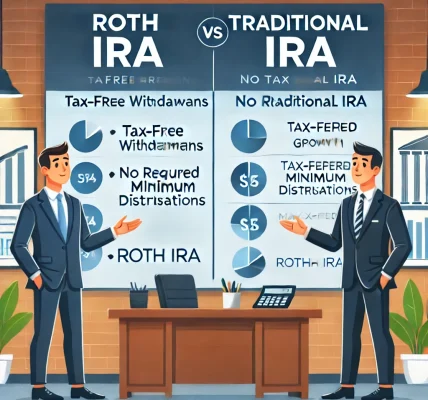Introduction
Retirement is a significant milestone that marks the shift from accumulating wealth to strategically spending it. While saving for retirement requires discipline and long-term planning, knowing how to effectively spend your savings without running out of funds is just as crucial. Many retirees struggle with the transition, fearing they might outlive their savings or mismanage their funds. This guide will help you navigate the transition smoothly while maintaining financial security and peace of mind.
Why Transitioning from Saving to Spending is Challenging
Shifting from a saver to a spender is a psychological and financial adjustment. The main challenges include:
- Fear of Outliving Savings – With increased life expectancy, retirees worry about depleting their funds too soon.
- Uncertainty About Market Fluctuations – Economic downturns and inflation can erode savings if not managed well.
- Healthcare and Unexpected Expenses – Rising medical costs and unforeseen emergencies require financial cushioning.
- Lack of a Spending Plan – Without a proper withdrawal strategy, retirees may overspend or underspend.
Understanding these challenges can help retirees develop a sustainable financial plan to ensure a comfortable lifestyle.
Step-by-Step Guide to Transitioning from Saving to Spending
1. Establish a Retirement Budget
Creating a budget is the foundation of managing retirement finances effectively. To do this:
- Calculate Fixed Expenses – Include housing, insurance, healthcare, and essential living costs.
- Estimate Variable Costs – Travel, entertainment, hobbies, and discretionary spending should be accounted for.
- Set a Withdrawal Plan – Decide how much to withdraw each year based on your retirement savings and expected lifespan.
2. Determine Your Safe Withdrawal Rate
A widely used strategy is the 4% rule, which suggests withdrawing 4% of your retirement savings annually to sustain a 30-year retirement. However, this may need adjustments based on market conditions, inflation, and personal circumstances.
Consider:
- Dynamic Withdrawal Strategies – Adjusting withdrawals in response to market performance.
- Bucket Strategy – Dividing savings into short-term (cash), mid-term (bonds), and long-term (stocks) investments to manage risk.
3. Convert Assets to Reliable Income Streams
Transitioning to spending doesn’t mean depleting your savings entirely. Instead, convert savings into structured income streams:
- Social Security Benefits – Delay claiming benefits to maximize payouts.
- Pensions (if applicable) – Understand payout options (lump sum vs. monthly annuities).
- Annuities – Provide guaranteed income but should be chosen wisely based on fees and returns.
- Dividend and Rental Income – Alternative income sources to support expenses.
4. Manage Taxes Efficiently
Taxes play a crucial role in retirement spending. Consider these strategies:
- Withdraw from Taxable Accounts First – This allows tax-advantaged accounts (401(k), IRA) to grow longer.
- Use Roth IRA Withdrawals – Tax-free withdrawals from Roth accounts can reduce overall tax burdens.
- Plan Required Minimum Distributions (RMDs) – Ensure timely withdrawals from traditional IRAs and 401(k)s to avoid penalties.
5. Protect Against Inflation
Inflation can erode purchasing power over time. To combat this:
- Invest in assets that outpace inflation, such as stocks and real estate.
- Consider Treasury Inflation-Protected Securities (TIPS) to safeguard purchasing power.
- Adjust withdrawals and budgets periodically based on inflation rates.
6. Maintain an Emergency Fund
Having at least 6-12 months’ worth of expenses in liquid savings helps cover unexpected costs, such as medical emergencies or home repairs, without dipping into investments.
7. Rebalance Your Investment Portfolio
As retirement progresses, shifting from high-risk to lower-risk investments ensures financial stability.
- Reduce stock exposure gradually while increasing bond holdings.
- Keep a portion in equities for long-term growth to combat inflation.
- Work with a financial advisor to rebalance the portfolio periodically.
8. Track and Adjust Your Plan Regularly
Monitor your financial situation annually and make necessary adjustments. Factors to consider include:
- Changes in living costs and healthcare expenses.
- Market performance and investment returns.
- Any new sources of income or unexpected financial obligations.
Common Mistakes to Avoid in Retirement Spending
- Overspending Early – Retirees often spend too much in the initial years, risking financial instability later.
- Underestimating Healthcare Costs – Medical expenses increase with age and should be factored into financial planning.
- Ignoring Inflation – Not adjusting withdrawals for inflation can reduce purchasing power over time.
- Withdrawing from Retirement Accounts Without a Strategy – Random withdrawals can lead to higher tax burdens and depleting savings too quickly.
- Failing to Seek Professional Guidance – A financial advisor can help tailor a sustainable withdrawal strategy based on your lifestyle and goals.
Conclusion
Transitioning from a retirement saver to a retirement spender requires careful planning, disciplined budgeting, and strategic withdrawals to ensure financial security. By setting a withdrawal plan, managing taxes, diversifying income sources, and adjusting investments, retirees can enjoy a financially stress-free life




